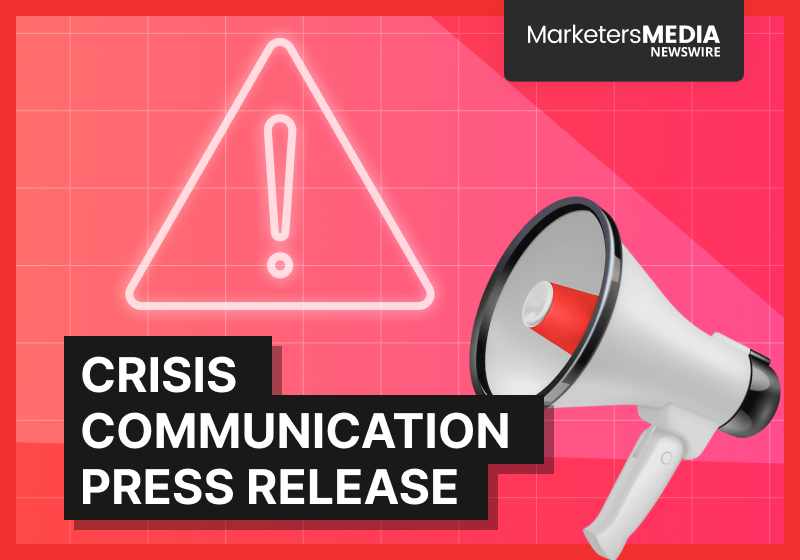Crises can damage any organization's reputation. A well-crafted press release is key to controlling the narrative, mitigating damage, and maintaining trust. This blog provides a step-by-step approach to writing an effective crisis communication press release.
So let’s begin by understanding the crisis itself.
Understanding the Crisis: The Foundation of Effective Communication
Imagine you're a doctor rushing to the emergency room. You wouldn't start treating a patient without first diagnosing the problem, right? The same principle applies to crisis communication. Before you fire off a single word in your press release, you absolutely must take a step back and understand the full scope of the situation. This isn't just about knowing what happened; it's about understanding why it happened, who it impacts, and what the potential ripple effects could be.
Crisis Assessment: Digging Beneath the Surface
A thorough crisis assessment is crucial. Gather all the facts, analyze the information, and ask tough questions to get a clear picture of the situation.
Here are the key questions you need to answer during your crisis assessment:
What exactly happened?
This is where you become an investigator. Don't settle for surface-level explanations. Dig deep to uncover the verifiable truth behind the crisis. What series of events led to this situation? Resist the urge to speculate; instead, focus on building a timeline of confirmed facts.
- Gather granular details: Document precisely what occurred, where it occurred, when it occurred, and who was involved.
- Identify the root cause: Don't just treat the symptoms; determine the underlying reason for the crisis. Was it a product malfunction due to a specific design flaw? A security breach exploiting a known vulnerability? A miscommunication stemming from unclear policies?
- Document everything: Keep a detailed record of your findings, including sources and supporting evidence.
Who is affected, and how?
Consider all potential stakeholders: customers, employees, investors, partners, the community. What are their immediate concerns? What are their potential losses? Empathy starts with understanding the impact on others.
- Example: "Customers whose data was compromised may be at risk of identity theft. We are providing free credit monitoring services to all affected individuals."
What is the potential impact on our organization?
This isn't about being selfish; it's about being realistic. Consider the financial implications, the reputational damage, the legal liabilities, and the impact on employee morale.
- Actionable Tip: Brainstorm potential scenarios – worst-case, best-case, and most likely. This will help you prepare for a range of outcomes.
What are the immediate needs?
Are there safety concerns? Do people need assistance? What resources are required to address the crisis? Prioritize these needs above all else.
- Think practically: "We are immediately deploying [Resource] to [Location] to provide [Specific Assistance]."
What are the legal and ethical considerations?
This is where you consult with your legal team and ensure you're complying with all applicable laws and regulations. Honesty and transparency are paramount.
- Important Note: Don't try to cover up anything. It will inevitably come to light, and the consequences will be even more severe.
Why is this important?
Because a generic, one-size-fits-all press release won't cut it. You need to craft messages that resonate with each stakeholder group and address their specific needs.
Determining Key Messages: The Pillars of Your Communication
Now that you understand the crisis and your audience, it's time to define your key messages. These are the core ideas you want to communicate in your press release. Think of them as the pillars that support your communication strategy.
Focus on these three key elements:
- Empathy: Show genuine concern for those affected. Use language that conveys compassion and understanding.
- Example: "We are deeply saddened by this incident and extend our heartfelt condolences to those who have been impacted."
- Accountability: Acknowledge responsibility where appropriate. Don't try to deflect blame or make excuses.
- Example: "We take full responsibility for the oversight that led to this error and are committed to preventing it from happening again."
- Action Plan: Outline the steps you're taking to address the crisis and prevent future incidents. Be specific and demonstrate a proactive approach.
- Example: "We are immediately implementing new security protocols, retraining our staff, and conducting a thorough review of our systems."
Remember: Your key messages should be consistent across all your communication channels. This will ensure that you're delivering a clear and unified message to all your stakeholders.
Structuring Your Crisis Communication Press Release
Alright, you've done the hard work of understanding the crisis, identifying your stakeholders, and defining your key messages. Now, it's time to put it all together and craft a press release that's clear, concise, and compelling. Think of this section as your blueprint for building a strong and effective communication tool. We're going to deconstruct the anatomy of a crisis communication press release, breaking down each key element and explaining how to use it to your advantage.
Headline:
In a crisis, time is of the essence, and attention spans are short. Your headline is the first, and sometimes the only, thing people will read. It needs to be clear, concise, and immediately convey the essence of the situation.
Here's what makes a good crisis communication headline:
- Clarity: Avoid jargon, sensationalism, or ambiguity. State the main point clearly and directly.
- Concision: Keep it short and to the point. Aim for 10 words or less.
- Factual Accuracy: Stick to the facts and avoid speculation.
- Relevance: Include keywords that relate to the crisis, but only if they add clarity and don't sensationalize the situation.
Examples of Effective Headlines:
- "[Company Name] Responds to [Specific Incident] at [Location]"
- "[Company Name] Addresses [Specific Issue] and Announces [Specific Action]"
- "[Company Name] Cooperating with Authorities in Investigation of [Specific Event]"
- "[Company Name] Issues Voluntary Recall of [Product] Due to [Reason]"
What to Avoid in Headlines:
- Blaming language: "Faulty Supplier Causes Product Recall" - Focus on solutions, not blame.
- Euphemisms: "Company Experiences Service Disruption" - Be direct about the nature of the problem.
- Overly General Statements: "Company Addresses Recent Events" - Lack of specifics raises suspicion.
Dateline:
The dateline is a small but important detail. It provides context and establishes the timing of the release. Simply include the city and state where the release is being issued, followed by the date.
Example:
NEW YORK, NY – October 26, 2023 –
Introduction (First Paragraph):
Your introduction is your opportunity to set the tone and grab the reader's attention. It should immediately acknowledge the crisis, summarize what happened, and express empathy and concern.
Key elements of an effective introduction:
- Acknowledge the Crisis: Don't try to bury the lede. Be direct about the issue.
- Summarize the Facts: Provide a brief and accurate overview of what happened.
- Express Empathy: Show genuine concern for those affected.
- Avoid Speculation: Stick to what you know and avoid making assumptions.
Example:
"[Company Name] is deeply concerned about the incident that occurred on [Date] at our [Location] facility. A [Specific Event] resulted in [Specific Consequence], impacting [Specific Group of People]. We are taking immediate action to address the situation and support those affected."
Body Paragraphs (Supporting Details):
The body paragraphs are where you provide the supporting details and expand on the information presented in the introduction. This is your chance to demonstrate your commitment to resolving the crisis and preventing future incidents.
Paragraph 2: More Detail on the Situation: Provide a clear and concise explanation of the crisis, including the timeline of events, the cause of the problem, and the extent of the impact.
- Focus on Accuracy: Double-check all facts and figures to ensure they are correct.
Paragraph 3: Action Taken: Outline the immediate steps the company is taking to address the crisis. Be specific and demonstrate a proactive approach.
- Highlight Concrete Actions: "We have established a dedicated hotline for affected customers," "We have dispatched a team of experts to investigate the cause of the incident," "We are providing temporary housing for displaced residents."
Paragraph 4: Remediation Efforts (Going Forward): Explain how the company plans to prevent similar incidents in the future. This shows commitment to long-term solutions.
- Demonstrate Long-Term Commitment: "We are implementing new safety protocols," "We are investing in enhanced security measures," "We are conducting a comprehensive review of our policies and procedures."
Collaboration with Authorities/Experts (Optional): If you're working with law enforcement, regulatory agencies, or industry experts, mention it to add credibility to your response.
- Example: "We are fully cooperating with the [Name of Agency] in their investigation of this incident."
Quote from a Key Spokesperson:
A quote from a trusted spokesperson can add a personal touch to your press release and reassure stakeholders that the company is taking the crisis seriously.
Choosing the Right Spokesperson:
- Credibility: Choose someone who is respected and trusted by your stakeholders.
- Authority: Select someone who is authorized to speak on behalf of the company.
- Empathy: Ensure the spokesperson can convey genuine concern and understanding.
Key Elements of an Effective Quote:
- Reinforce Key Messages: The quote should reiterate the core messages you want to communicate.
- Express Sincerity: The quote should sound genuine and authentic.
- Demonstrate Leadership: The quote should convey a sense of control and direction.
Example:
"We understand the concern and frustration this situation has caused," said [Name], CEO of [Company Name]. "Our top priority is the safety and well-being of our customers and employees. We are committed to taking all necessary steps to address this issue and prevent it from happening again."
Call to Action (CTA):
The call to action tells readers what you want them to do next. Direct them to where they can find more information or get assistance.
Examples of Effective CTAs:
- "For more information, please visit [Website]."
- "To contact our customer support team, please call [Phone Number]."
- "For media inquiries, please contact [Media Contact]."
Boilerplate:
The boilerplate is a short paragraph that provides a brief overview of the company. Keep it concise and focused on the company's mission and values. This is usually standard and pre-written.
Dos and Don'ts of Crisis Communication Press Releases
So, you've got the structure down, but writing a good crisis communication press release is more than just filling in the blanks. It's about navigating a minefield of potential missteps that can amplify the crisis and further damage your reputation. This section is your guide to avoiding those pitfalls. Consider it your crisis communication cheat sheet – a list of essential Dos and Don'ts to ensure you're putting your best foot forward.
Dos: Essential Practices for Effective Crisis Communication
Think of these as the golden rules of crisis communication. Follow them, and you'll be well on your way to managing the situation effectively.
Do Be Prompt: Time is of the essence. The longer you wait to respond, the more likely misinformation will spread and the narrative will be shaped by others.
- Practical Tip: Aim to issue a press release within 12-48 hours of the crisis occurring. If you need more time to gather information, release a brief holding statement acknowledging the situation and promising a more detailed update soon.
Do Be Transparent: Share accurate and verifiable information. Don't try to hide anything or downplay the situation.
- Why Transparency Matters: Hiding information breeds suspicion and erodes trust. Be open and honest about what you know, even if it's uncomfortable.
Do Be Honest: Avoid misleading statements or outright lies. Your credibility is on the line.
- Remember: It's better to admit you don't have all the answers than to provide inaccurate information.
Do Be Empathetic: Show genuine concern for those affected. Use language that conveys compassion and understanding.
- Example: "We understand the anxiety and frustration this situation is causing, and we are committed to supporting those who have been impacted."
Do Be Accountable: Acknowledge responsibility where appropriate. Don't try to deflect blame or make excuses.
- Taking Responsibility: Even if you're not entirely at fault, acknowledge the impact of the crisis and express your commitment to making things right.
Do Be Proactive: Highlight the steps you're taking to address the crisis and prevent recurrence.
- Show, Don't Just Tell: Provide specific details about the actions you're taking, such as implementing new safety protocols, retraining staff, or investing in enhanced security measures.
Do Use Clear and Simple Language: Avoid jargon, technical terms, or legalistic language.
- Communication for All: Write in a way that anyone can understand, regardless of their background or expertise.
Do Proofread Carefully: Ensure the release is free of errors in grammar, spelling, and punctuation.
- Get a Second Pair of Eyes: Have someone else review the press release before it's distributed to catch any mistakes you might have missed.
Don'ts: Mistakes to Avoid at All Costs
These are the red flags of crisis communication. Steer clear of them, and you'll significantly reduce the risk of making the situation worse.
Don't Speculate: Stick to the facts. Avoid making assumptions or predictions about what might happen in the future.
- Focus on What You Know: Only report on information that you can verify.
Don't Blame Others: Focus on solutions, not finger-pointing. Assigning blame only serves to alienate stakeholders and distract from the real issues.
- Take Ownership: Even if another party contributed to the crisis, focus on what you are doing to address the situation.
Don't Make Promises You Can't Keep: Set realistic expectations. Overpromising and underdelivering will only further damage your credibility.
- Underpromise, Overdeliver: It's better to set modest goals and exceed them than to make grandiose promises you can't fulfill.
Don't Ignore the Crisis: Silence can be interpreted as indifference or guilt.
- Address the Issue Promptly: Even if you don't have all the answers, acknowledge the crisis and let stakeholders know you're working on it.
Don't Use Humor or Sarcasm: It's never appropriate in a crisis.
- Maintain a Serious Tone: Show respect for those who have been affected by the crisis.
Don't Delete Negative Comments or Try to Suppress Criticism: Address concerns directly and professionally.
- Engage with Your Audience: Respond to comments and questions on social media and other online platforms. Show that you're listening and willing to address their concerns.
Don't Get Defensive: Even if you believe you're being unfairly criticized, avoid getting defensive or argumentative.
- Listen and Learn: Use criticism as an opportunity to improve your communication and your response to the crisis.
Don't Forget Legal Review: Ensure that your press release has been reviewed by your legal team before distribution.
- Protect the Company: Your legal team can help you avoid making statements that could create legal liabilities.
Now that we've covered the rules of the road, let's take a look at some real-world examples of crisis communication press releases – both the good, the bad, and the downright ugly. By analyzing these examples, we can learn from the successes and failures of others and refine our own approach to crisis communication.
Examples of Effective (and Ineffective) Crisis Communication Press Releases
Alright, theory is great, but nothing beats learning from real-world examples. In this section, we'll dissect both successful and disastrous crisis communication press releases. By analyzing what worked and what didn't, you'll gain invaluable insights into crafting your own effective responses.
Consider this your crisis communication "autopsy" – examining the successes and failures to learn how to improve your own strategies.
Analyzing Examples: Learning from Successes and Failures
Let's start by looking at some examples from the resources you provided and a few other notable cases. We'll focus on key elements like headline effectiveness, tone, clarity, and call to action.
Example 1: Tylenol's 1982 Crisis (A Classic Success)
- The Crisis: In 1982, seven people in the Chicago area died after taking Tylenol capsules that had been laced with cyanide. This triggered a massive public health scare and threatened the very existence of the Tylenol brand.
- Key Elements of Their Response:
- Immediate Recall: Johnson & Johnson, Tylenol's parent company, immediately recalled all Tylenol capsules from store shelves, at a cost of over $100 million.
- Transparent Communication: They were open and honest with the public about the situation, providing regular updates through press conferences and press releases.
- Focus on Safety: They emphasized their commitment to consumer safety above all else.
- Innovative Solutions: They introduced tamper-resistant packaging to prevent future incidents.
- Why It Worked: Johnson & Johnson's swift and decisive action, coupled with their transparent communication, helped to restore public trust in the Tylenol brand. They prioritized safety over profits and demonstrated a genuine concern for their customers.
- Headline Example (Hypothetical): "Johnson & Johnson Voluntarily Recalls All Tylenol Capsules Nationwide Following Contamination Incident" - Clear, concise, and factual.
Example 2: Domino's Pizza's Employee Tampering Incident (Social Media Crisis Handled Well)

- The Crisis: In 2009, two Domino's employees in North Carolina posted a video online of themselves engaging in unsanitary acts with the food. The video went viral, causing widespread outrage and damaging Domino's reputation.
- Key Elements of Their Response:
- Rapid Response: Domino's acted quickly to address the situation, firing the employees involved and issuing a public apology.
- Social Media Monitoring: They actively monitored social media conversations to understand the extent of the damage and respond to concerns.
- Personal Apology: The president of Domino's U.S. issued a video apology, expressing his disgust and promising to take steps to prevent similar incidents in the future.
- Why It Worked: Domino's rapid response, coupled with their genuine apology and their active engagement on social media, helped to contain the damage and restore public trust.
- Headline Example (Hypothetical): "Domino's Pizza Takes Immediate Action Following Employee Misconduct Incident" - Focuses on the company's response and avoids sensationalizing the employees' actions.
Example 3: United Airlines' Passenger Removal Incident (A PR Disaster)
- The Crisis: In 2017, a video surfaced showing a passenger being forcibly removed from a United Airlines flight because the airline had overbooked the flight and needed seats for its employees. The video went viral, sparking widespread outrage and damaging United's reputation.
- Key Elements of Their Initial Response (What Not to Do):
- Tone-Deaf Apology: United's initial apology was seen as insincere and dismissive, focusing on the airline's policy rather than the passenger's experience.
- Lack of Empathy: The CEO's initial statement referred to the passenger as "disruptive" and failed to acknowledge the severity of the situation.
- Slow Response: United's initial response was slow and hesitant, allowing the crisis to escalate out of control.
- Why It Didn't Work: United's tone-deaf apology, lack of empathy, and slow response only served to fuel the outrage and further damage their reputation.
- Headline Example (What They Should Have Used): "United Airlines CEO Issues Apology for Passenger Incident, Announces Review of Overbooking Policies" - Acknowledges the severity, takes responsibility, and outlines a plan for improvement.
These examples underscore a fundamental truth: crisis communication is inextricably linked to reputation management. How you respond in a moment of crisis not only affects the immediate situation but also shapes the long-term perception of your brand. As we move into the conclusion, let's consider how these principles can be integrated into a broader strategy for building a resilient and trustworthy reputation.
Final Thoughts
We've covered a lot of ground in this guide, from understanding the nuances of a crisis to crafting a press release that resonates with empathy and action. But the most crucial takeaway is this: crisis communication isn't just about reacting; it's about preparing. Like a well-stocked emergency kit or a meticulously planned fire drill, a robust crisis communication plan is an investment in your organization's resilience.
The examples we've dissected have shown us that even the best-laid plans can be tested. However, those companies that embraced transparency, accountability, and genuine concern weathered the storm far more effectively. Remember Tylenol? They didn't just survive; they rebuilt their brand stronger than ever. Contrast that with United Airlines' initial response, a stark reminder that a tone-deaf approach can quickly escalate a crisis into a full-blown reputational disaster.
So, where do you go from here? Start by taking a critical look at your current crisis communication plan (or create one if you don't have one!). Ask yourself:
- Is it up-to-date? Does it reflect the current realities of your business and the evolving media landscape?
- Is it comprehensive? Does it cover a wide range of potential crises, from product recalls to data breaches to social media firestorms?
- Is it actionable? Does it provide clear and concise instructions for your team to follow in the event of a crisis?
What’s The Next Step
Facing a crisis demands swift and decisive action, and that includes getting your message out quickly. To help you streamline the process, we've got an AI-Powered Press Release Generator that can help you craft a compelling crisis communication press release in minutes. Simply input the key details of the situation, and our AI will generate a draft that's tailored to your specific needs.
Don't wait until a crisis strikes to start thinking about communication. By taking proactive steps to prepare, you can protect your reputation, maintain stakeholder trust, and ensure your organization can weather any storm.
The world is unpredictable, but with preparation, empathy, and clear communication, you can navigate the challenges and emerge stronger on the other side.
Free Press Release Template
Tell us where to send your PDF:







